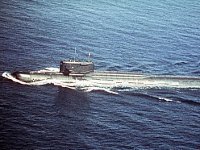K-137 Leninist submarine scared Americans 45 years ago
Forty-five years ago, the USSR Navy was handed over the first in a series, unique second-generation nuclear submarine K-137. The boat, named "Leninist", gave origin to a family of local strategic missile submarines. The boats Project 667 and its modifications became the most numerous in the world.

K-137 "Leninist" Project 667 gave start to a series of the second generation nuclear submarines that carried on board 16 ballistic missiles and were capable of launching them from under the water. Russians called this project "Navaga", and the Americans, flabbergasted by unexpectedly high technical capabilities of Soviet shipyards, called them "Yankees." Documentary sources, both Russian (Soviet) and foreign ones confirm that when boats of this project went to sea (at least in the early years), the entire U.S. Navy would be alarmed.
The famous Severodvinsk Sevmash alone built 24 such submarines in six years. The first submarine developed in CDB "Rubin", became the originator of the "gold" series of ships of Projects 667A, 667B, 667BD, 667BDR, and 667BDRM with more advanced missile systems.
As reported to "Pravda.Ru" by the press service of Sevmash, the factory built 59 submarines of this type, constantly improving construction technology, implementing aggregate-modular method of equipment installation, accumulating experience of testing, and honing the skill and professionalism of the workers. Boats of Project 667 BDRM, or its modification, 667, to this day form the basis of the naval component of the strategic nuclear forces of Russia.
For the creation of Project 667A, 304 employees of Sevmash were awarded orders and medals. "Leninist" became school of courage for the crew. 25 officers who served on that submarine at different times later became commanders.
Nearly two dozen were granted admiral rank. During the 27 years of hard combat service submarine K-137 made 20 autonomous trips. During this period, over two hundred people were awarded state awards. In 2004, the decommissioned K-137 was scrapped at "Star" facility in Severodvinsk.
After the complete utilization of K-137, a great deal of scrap metal was recovered, namely: 3,500 tons of steel (300 tons of stainless steel, 1,100 tons of low-magnetic, 1,900 tons ungraded); 322 tons of ferrous metals, 50 tons of copper, 70 tons of brass, 70 tons of bronze and 30 tons of copper-nickel and five tons of aluminum scrap. That is all that remained of the once formidable missile submarine of strategic purpose.
There are many memories of the "Leninists" as the ancestor of a type of tough submarines, not only in Severodvinsk but the entire Russia. Recently in Severodvinsk an event was held dedicated to the commissioning of the first strategic submarine of the second generation. The event was attended by those who built and tested "Leninist", carried military services on board and participated in the repairs. Shipbuilders and sailors shared vivid memories in a warm and friendly atmosphere.
Incidentally, due to a large number of this type of naval ships, there is multitude of stories about them. I served on these boats for over 12 years, recording the navy "gems." As a result, a funny (according to my colleagues) book "Urgent dive" was born. Paying tribute to our wonderful boat, I will tell a real story that occurred on board this particular type of boat. One cannot survive in the Navy without humor. Maybe the boats of this design served for so long because their crews never lost their sense of humor.
Once, a new chief medical officer was appointed for nuclear submarine 667. A lieutenant, green and fresh, started his service rapidly and ferociously. A boat mechanic, very proud of the length of his medical record that included all possible ailments and illnesses, diagnosed the new doctor: "He has a terrible beast of a workaholic inside him. However, in a month or two he will get better. The scary serpent-workaholic will wither and turn into a modest little warm. The disease will take a milder form, for example, simulated intense activity. Attacks of this illness are delightfully treated at sea ... ".
I must say, the ship's magician-mechanic, as always, was right. After six months of service on the boat the young doctor reached a breaking point and rarely let his beast-workaholic outside of the iron door in the fifth bay. Actually, the new doctor got to the boat in the midst of preparing the boat and its crew for the check at sea, before the old boats' last trip. It was already clear that next year it will go to Severodvinsk for scraps. The boat was visited by diligent professionals of all ranks and suits. They conducted an assessment in order to see whether the old boat can handle a long trip.
One evening, after another hectic operation of loading produce into the cabin of the assistant commander, exhausted by watchful vigil over the safety of the edibles on the way from the pier to the storage and fishing voracious predators among sailors, there was a knock on the door. The grim Doctor reported: "There is an epidemic! Presumably dysentery." He showed him a glass jar with food digestion products, found by accident (?) in the toilet in the fifth bay.
The assistant got upset. Dysentery on the boat a few days before the release was equal to a state of emergency. The struggle for health and honor of the crew began immediately. First, the assistant tried to explain to the doctor that after loading food on the boat one could always find strange particles in the feces of the personnel, including half-digested cans. The doctor was adamant. He personally studied the content of the jar, and the analysis was confirmed by the hospital where the doctor sent a sample an hour before. The assistant gave up when he heard doctor's official statement: "According to the guidelines and job descriptions, we must take immediate appropriate measures."
The eyes of the commander who heard the sad report of the incident from the assistant next morning were bloodshot. After hearing the report of the medical lieutenant, the commander rushed to make a speech in front of the crew but changed his mind. He just waved his hand, cursed and retired to his cabin. A decision was made to find the mysterious main carrier of the alleged deadly dysentery bacilli.
The crew was taken to the shore barracks. The detection of the signs of the epidemic was reported to all imaginable authorities. A hospital team of men in white coats with glass containers arrived on the boat. The officials at the headquarters of the flotilla were terrified. If the report of dysentery on a warship is confirmed, it would have to be reported to the highest Navy command.
The same day, the entire crew was tested for fecal bacteria. At the headquarters, the officials were impatiently waiting for test results. To the delight of all, after the incubation period, the matter planted into glass bowls by the mighty young doctor did not mature. It may well be that it was cured by the healing powers for the doctor-workaholic.
Andrey Mikhailov
Pravda.Ru
Subscribe to Pravda.Ru Telegram channel, Facebook, RSS!



